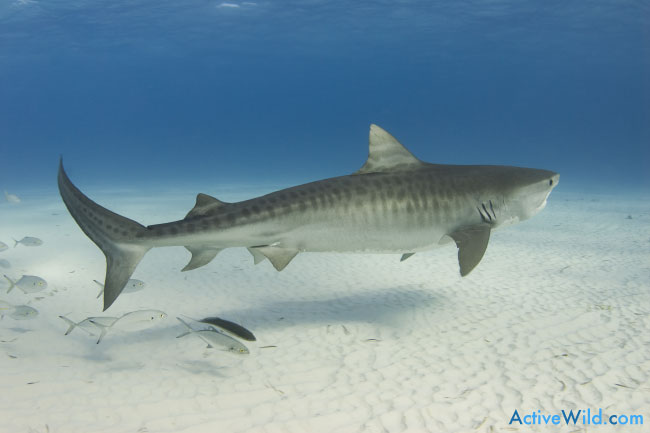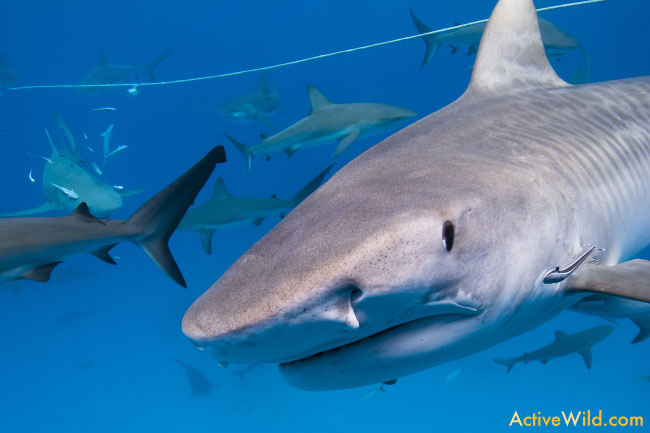Tiger Shark facts for kids (and adults), with pictures, information and video.
Tiger Shark Facts
The Tiger Shark is one of the most feared ocean predators. With explosive speed, powerful jaws, and excellent eyesight, the Tiger Shark’s bad reputation is well-deserved. Some people consider it to be even more dangerous than the Great White Shark! It certainly looks the part, with its menacing tiger-like stripes. Let’s find out more about this underwater hunting machine …
(Scroll down to the end of the article for the top ten Tiger Shark facts, or read on for in-depth information.)
Related Articles
- Types Of Sharks: Shark Species List with Pictures & Facts
- Is a Shark a Fish?
- Great White Shark Facts, Pictures and Information
- Greenland Shark Facts, Pictures and Information
- Shark Facts, Pictures and Information
- Killer Whale Facts, Pictures and Information
- Dolphin Facts, Pictures and Information
Tiger Shark Scientific Name and Family
The Tiger Shark’s scientific name is Galeocerdo cuvier. It is a member of the requiem shark family Carcharhinidae.
Other requiem sharks include the Spinner Shark, the Blacknose Shark, the Blacktip Shark, the Blacktail Reef Shark, and the Blacktip Reef Shark.
Tiger Shark Size & Appearance
The Tiger Shark gets its name from the tiger-like stripes and spots on the sides of its body. These markings fade as the shark matures, and are barely visible on older individuals.
The Tiger Shark is a bulky, powerful-looking shark, with a blunt, wide nose that allows it to make quick turns. It has two dorsal fins (fins on its back), and a pointed tail fin which is longer on the top than the bottom.
The Tiger Shark has five gill slits. Like many sharks, it has nictitating membranes that slide over its eyes. These are clear covers that protect the eyes.
Like many sharks, the Tiger Shark has dark upperparts and pale undersides. This is known as ‘countershading’. Because natural light generally comes from above, the shark’s lighter undersides can confuse observers and break up its outline. This conceals the shark from potential predators and prey.
The Tiger Shark’s sides and back are grey-blue or green and its underparts are almost white.
Tiger Shark Video
Get up close and personal to the Tiger Shark in this amazing video ...
Tiger Shark Facts For Kids: How Big Is A Tiger Shark?
Length
The Tiger Shark is the world’s fourth-largest shark. Only the Whale Shark, Basking Shark and Great White Shark are bigger.
(Sharks such as the Greenland Shark are a similar size, but have not been studied in as much depth as the Tiger Shark.)
Most tiger sharks are between 3 and 4.5 m (10 to 14 ft.) in length. Female Tiger Sharks are larger than males.
Weight
Tiger sharks weigh between 385 and 635 kg (850 and 1,400 lb)
Largest Tiger Shark
Occasionally, bigger Tiger Sharks are recorded. The Tiger Shark can attain a length of over 5.5 m (18 feet), and a weight of over 900 kg (2,000 lb).
One of the largest tiger sharks ever reported was caught near Australia. It weighed 1,524 kg (3,360 lb), and was around 5.5 m (18 feet) long.
Where Do Tiger Sharks Live?
The Tiger Shark is found in tropical and subtropical waters. It is present in the Atlantic, Pacific and Indian oceans. The Tiger Shark is most often found in coastal waters, and is present around the United States, South America, Australia and Africa.
Tagging studies have found that some Tiger Sharks stay in the same area, whereas others are more nomadic. The largest distance a tagged Tiger Shark has been found to cover was 3,430 km (2,130 miles).
The deepest a Tiger Shark has been recorded swimming at was 350 m (1,150 ft.).
What Do Tiger Sharks Eat? Tiger Shark Diet & Hunting
The Tiger Shark is an apex predator (it has no natural predators), and is top of the food chain.
The Tiger Shark comes inshore to eat, usually at night. Its diet is extremely varied, and includes fish (including other sharks), birds, sea turtles, dolphins, squids, sea snakes, rays, seals and many other animals.
The Tiger Shark will snap out at and swallow almost anything that falls within the range of its powerful jaws. Its stomach has been found to contain license plates, tyres, clothing and other man-made objects. Because of this the Tiger Shark is known as ‘The Wastebucket of the Sea’.
Due to its camouflage and slow swimming speed, the Tiger Shark is often only seen by its prey at the last minute. The Tiger Shark is capable of a powerful burst of acceleration, which it uses to capture its prey.
Reproduction
Tiger Sharks are mature at around 2.75 m (9 ft.). They attain this size after around 5-10 years.
Unlike all other requiem sharks, the Tiger Shark is ovoviviparous; its eggs develop inside the female’s body, and it gives birth to live young.
The female Tiger Shark gives birth to an average of 30 to 35 pups. New-born Tiger Sharks are between 51 and 76 cm (20 and 30 in) in length. They are extremely vulnerable at this stage, and many are predated by other sharks, including other Tiger Sharks.
Are Tiger Sharks Endangered?
Tiger sharks are rated Near Threatened on the IUCN Red List.
Tiger Sharks are targeted by fishermen, and are also caught as bycatch when fishermen are targeting other species. (Bycatch is when a species is caught by mistake.)
Tiger Sharks are caught for their flesh, fins, skin and liver oil.
Because Tiger Sharks can be dangerous to humans, their populations are sometimes controlled in tourist areas. This is achieved with netting and other methods.
Tiger Sharks are occasionally preyed upon by Killer Whales.
Tiger Shark Facts for Kids: Top Ten Facts
- The Tiger Shark’s scientific name is Galeocerdo cuvier.
- It is a member of the requiem shark family Carcharhinidae.
- The Tiger Shark gets its name from the tiger-like stripes along its sides. These stripes fade as the shark gets older.
- The Tiger Shark is the fourth-largest shark species in the world.
- The tiger shark is considered by some to be even more dangerous than the Great White Shark.
- The Tiger Shark exhibits ‘countershading’. This is where an animal’s upperparts are dark and the undersides are pale. This provides camouflage from predators and prey.
- Most tiger sharks are between 3 and 4.5 m (10 to 14 ft.) in length, and weigh between 385 and 635 kg (850 and 1,400 lb).
- One of the largest tiger sharks ever reported weighed 1,524 kg (3,360 lb), and was around 5.5 m (18 feet) long.
- The Tiger Shark has an extremely varied diet, which includes, fish, dolphins, and jellyfish.
- The Tiger Shark is an apex predator.
Tiger Shark Facts For Kids: Conclusion
We hope that you have enjoyed reading about the Tiger Shark. Here are some more articles you may be interested in …





